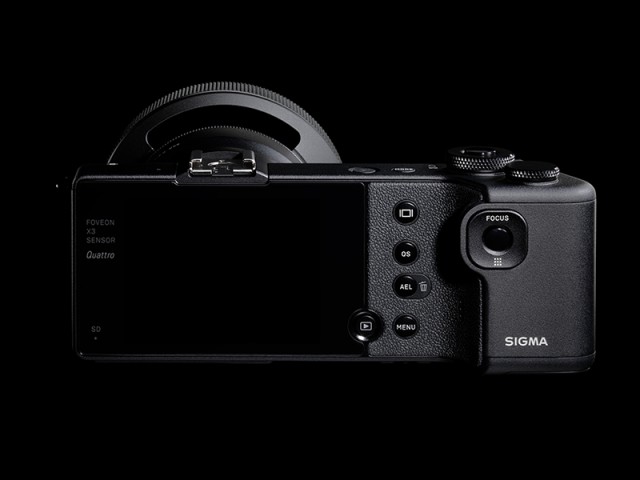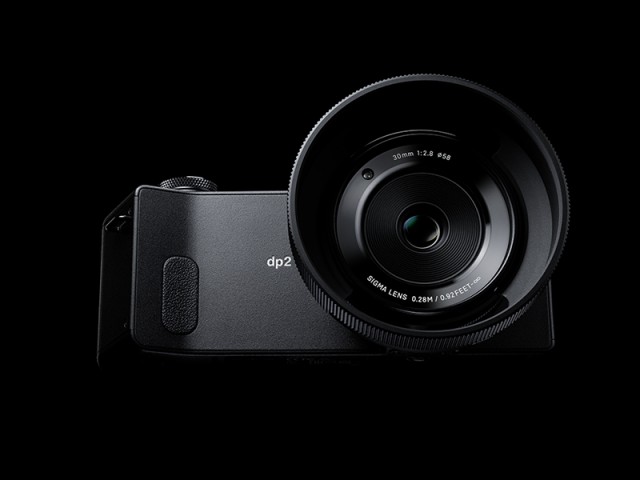
Sigma has announced a trio of new Foveon APS-C camera, dubbed the dp Quattro line. The cameras will carry the model names dp1, dp2 and dp3 Quattro and feature a unique body shape.

The Sigma dp2 Quattro will be the first camera in the series and will feature a 30mm f/2.8 lens and a 30MP Foveon sensor, which Sigma says matches the resolution of a 39MP Bayer sensor. The dp1 and dp2 Quattro cameras will sport a 19mm and 50mm lens, respectively, and will be released at a later date.


No word yet on pricing or availability of the dp2 Quattro, although it is confirmed to come before the dp1 and dp2.
Check out the full press release below for more details on the new Quattro line.
Sigma Quattro Press Release
The Sigma Corporation is pleased to announce the new generation of high image quality compact cameras “SIGMA dp” that incorporates a newly developed Foveon X3 direct image sensor (generation name: “Quattro”).
Unique and without peer among image sensors, the Foveon direct image sensor is similar to traditional color film in that its multiple layers capture all of the information that visible light transmits. Along with Sigma’s proprietary image processing technology, this sensor produces incredible resolution, precise gradation, gorgeous color, breathtaking realism with a 3D feel. In other words, full-bodied image quality.
For the new dp series, we rethought and redesigned every aspect of the camera, including the sensor, engine, lens, and body. While retaining its famous textural expression, which seems to give form to the air itself, the updated Foveon direct image sensor produces images that are more colorful, rich, deep, and faithful than ever before.
To a radical degree, the new-generation dp series embodies Sigma’s philosophy of creating cameras that produce works of art. Featuring the highest level of fundamental performance, this series unites artistic expression and daily experience as no other cameras can.
[Special Features]
With every element optimized for image quality, this camera is ready to produce works of art
Thanks to its optimized design featuring a fixed focal length lens and integrated body, the dp series offers both sensor and lens performance at the highest level. The result is full-bodied image quality.
In addition to superior holding performance, the camera body offers a balanced shape, layout, and weight distribution. With all of its elements designed for image quality, the dp offers highly intuitive operation. Its complete and robust specification allows the photographer to concentrate fully on photography itself and leverage the camera’s potential to produce outstanding images.
In everyday life, the dp series lets photographers find unexpected opportunities for experiencing emotion and enjoy photography and personal expression in exciting new ways. It is an outwardly simple yet extremely powerful embodiment of Sigma’s philosophy of photography.
Wide-angle, standard, and medium telephoto options
All of the fundamental photographic approaches in one lineup of three cameras
The dp series comprises three fixed focal length cameras, each of which features a different basic focal length for a different fundamental photographic approach: the wide-angle dp1 Quattro at 19mm, the standard dp2 Quattro at 30mm, and the medium telephoto dp3 Quattro at 50mm (respectively equivalent to 28mm, 45mm, and 75mm on a 35mm lens). Moreover, the three models share an exciting new camera body that brings out the best performance from the lens and image sensor.
It’s a simple but powerful lineup that delivers medium format-level image quality anywhere, anytime. Take all three with you and select as needed for the perfect shot. Only the dp series puts so much luxurious photographic potential in your hands.
The world’s only image capture system to use vertical color separation technology
Starting with our very first digital camera, we have featured the Foveon direct image sensor, which offers radically better image quality than any other sensor available. Leveraging the light absorption characteristics of silicon, the sensor comprises three layers of photodiodes, each at a different depth within the silicon and each corresponding to a different RGB color. Since it is the only sensor to use this superior vertical color separation technology, it is also the world’s only direct image sensor.
Almost all other image sensors are mosaic sensors, which use an array of RGB color filters in a single horizontal plane to capture color information. Each pixel is assigned only one of the three colors and cannot capture all three colors at once. In contrast, the Foveon direct image sensor captures color vertically, recording hue, value, and chroma accurately and completely for each pixel.
In the Foveon direct image sensor, there are no color filters, which cause a loss of information transmitted by light. Moreover, there is no low-pass filter needed to correct the interference caused by a color filter array. Finally, unlike the data from other sensors, which requires artificial interpolation to “fill in” missing colors, the data from the Foveon direct image sensor is complete for every single pixel and requires no interpolation. The unique technological principle of this sensor produces consistently outstanding image quality.
Newly developed Foveon X3 Quattro direct image sensor
Now featuring 39 megapixel-equivalent ultrahigh resolution
Capturing the information transmitted by light vertically instead of horizontally, the full-color image capture system of the Foveon direct image sensor is the only one of its kind in the world. This system makes possible the sensor’s full-bodied image quality, which is characterized by rich tone and gradation and texture that one can almost touch.
The newly developed Foveon X3 Quattro is the latest generation of this unique sensor. While retaining the distinctive characteristics of its predecessors, it offers an even higher level of image quality. In addition to 30% higher resolution, the volume of image data has become lighter, and it enables much faster image processing and lower current consumption.
At the same time, able to maintain the same exacting standard of image quality while increasing megapixels and enhancing noise characteristics, this 1:1:4 solution was the inspiration for the name of the current generation of Foveon sensor: “Quattro.”
Newly developed TRUE III image processing engine
Optimized for processing Foveon X3 Quattro direct image sensor data
The new dp series cameras feature the newly developed TRUE (Three-layer Responsive Ultimate Engine) III. This image processing engine has evolved in pace with our Foveon direct image sensor and incorporates all of the image processing expertise we have developed over the years. Thanks to new refinements, it is the ideal engine for processing the rich and complex image data produced by the new-generation Foveon X3 Quattro direct image sensor. Our proprietary algorithm makes possible ultrafast processing of an immense volume of image data without any deterioration of the final images. The result is high-definition, 3D-like photographs with outstandingly rich color detail.


I think it is almost unbelievable that they would say in their announcement that to have 3 focal length options, consumers need to purchase all 3 cameras! Sigma has some great tech and ideas, but I don’t feel they execute it very well.
Agreed. Sigma has been knocking it out of the park with its lens lineup. However, it seems Sigma’s camera roadmap has never found the right path and some things seem to be way off the mark.
Today’s on the go photographer wants a modular system, like the sony approach. They embrace rather than alienate: Use your existing lens line(with appropriate adapter) on any of the NEX line, or the new Alpha line replacing it and you are good to go. Compelling a photographer to have to buy all three must mean they aim to sell them for under $1,000 or so. Otherwise, they might look to wide to carry.
Too bad the camera has such mundane lens selection. As an architectural and commercial photographer I like the pixel count, but don’t care for the focal lengths.